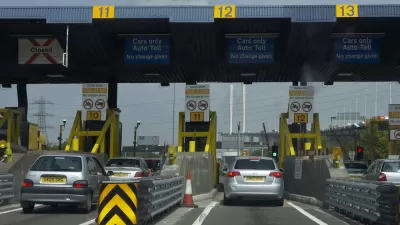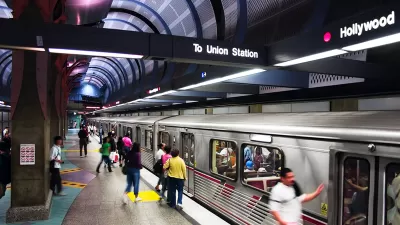In two new exhibits on Los Angeles's modern architectural history - part of the sprawling Pacific Standard Time Presents initiative - the city's infamous infatuation with the automobile is examined and then left behind in the rear-view mirror.
"'Los Angeles' identity is inextricably linked with the automobile,' reads the first line of wall text opening the Getty's current show about postwar architecture in Los Angeles ['Overdrive: L.A. Constructs the Future 1940-1990']," observes Alissa Walker. "Is driving what we talk about when we talk about L.A.'s modern architecture?", she asks.
"It was with trepidation that I headed to the A+D Museum to see 'Windshield Perspective,' which is up through July 9. In my mind the title represented the worst stereotype of L.A., the idea that the city was designed for the car, its architecture is best appreciated from that car, and God forbid you ever get out of that car."
However, Walker finds that the exhibition, which examines L.A.'s built environment using a 12-block stretch of Beverly Boulevard, was not what she expected. "While it is about buildings, [curator Greg] Goldin's exhibition actually subverts the celebration of modernism in all the other PSTP shows."
"We're duking it out with them," he says. "This is the idea that the real design of L.A. is happening in the streets, that we’re making and remaking the city here on places like Beverly."
"Pacific Standard Time Presents gives us a chance to see how L.A. was made modern, but it also chronicles the rise and the fall of the car in Los Angeles culture," concludes Walker. "Maybe, by seeing this narrative so persuasively presented in museums, alongside the artifacts of other cultures, we can finally admit that our affair with the automobile is history."
FULL STORY: Is Our Discussion of L.A. Architecture Too Focused on Cars?

Maui's Vacation Rental Debate Turns Ugly
Verbal attacks, misinformation campaigns and fistfights plague a high-stakes debate to convert thousands of vacation rentals into long-term housing.

Planetizen Federal Action Tracker
A weekly monitor of how Trump’s orders and actions are impacting planners and planning in America.

In Urban Planning, AI Prompting Could be the New Design Thinking
Creativity has long been key to great urban design. What if we see AI as our new creative partner?

King County Supportive Housing Program Offers Hope for Unhoused Residents
The county is taking a ‘Housing First’ approach that prioritizes getting people into housing, then offering wraparound supportive services.

Researchers Use AI to Get Clearer Picture of US Housing
Analysts are using artificial intelligence to supercharge their research by allowing them to comb through data faster. Though these AI tools can be error prone, they save time and housing researchers are optimistic about the future.

Making Shared Micromobility More Inclusive
Cities and shared mobility system operators can do more to include people with disabilities in planning and operations, per a new report.
Urban Design for Planners 1: Software Tools
This six-course series explores essential urban design concepts using open source software and equips planners with the tools they need to participate fully in the urban design process.
Planning for Universal Design
Learn the tools for implementing Universal Design in planning regulations.
planning NEXT
Appalachian Highlands Housing Partners
Mpact (founded as Rail~Volution)
City of Camden Redevelopment Agency
City of Astoria
City of Portland
City of Laramie




























